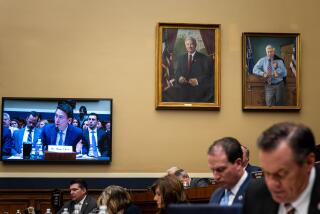Column: Coronavirus, the outbreak narrative and how our fear fuels our xenophobia and racism

- Share via
On Tuesday, around midnight, someone uploaded a video to Twitter showing emergency vehicles responding to an incident at an apartment complex near USC, the Lorenzo, known to be popular with Chinese international students.
The post claimed it was a case of coronavirus, and a screenshot of an email from the Lorenzo’s manager, Chance Kidd, seemed to confirm that.
The news that the first reputed coronavirus case in the center of Los Angeles had been detected near USC immediately went viral. A lot of people tweeted panicked, performative posts about hand-washing and the threat of disease. One poster claimed a friend’s roommate’s brother’s girlfriend had been infected.
The university later clarified that no coronavirus case had been discovered at the Lorenzo. And despite repeated requests for comment, Kidd and the Lorenzo declined to explain why they had made such a claim.
This is our new normal — a rumor becomes a fact, then turns back into a rumor, with no explanation. A dangerous event halfway around the world becomes entertainment for a night. The coronavirus, to a lot of us, is just another piece of content.
To me this is one of the weirdest effects of social media on society. Our opinions used to sit safely inside our heads, only occasionally causing trouble at the Thanksgiving dinner table. Now they war on our feeds every second, colliding and creating social frictions we’ve never experienced before.
Most of the time, I think this is good. Although many lament the loss of some fabled age of civility, I think a lot of us are just experiencing the discomfort of having to confront and value perspectives as we’ve never had to before. Jokes about minorities aren’t as funny when minorities are part of the audience. Novelists writing about the Mexican border now must confront the fact that they might have readers who ask them to do so accurately. It’s the age-old adage of reading the room — except social media are a room with potentially every kind of person in it.
But it also means that your joking posts about coronavirus — about frantically washing your hands and how you’re not the “diseased” kind of Asian — will probably appear on the feeds of someone with family whose relatives may be suffering or terrified. And it will probably make them very angry.
They have made me furious. I have relatives who live near Wuhan, where millions of people are under lockdown amid the declaration of a global health emergency by the World Health Organization.
Let’s be clear about this: Your fear does not justify your racism and xenophobia. Your jokes and performative panic about the coronavirus are not funny. They are deeply pointless and trivialize something that should be taken seriously. And they are creating an environment of fear, panic and disinformation that’s more dangerous than the disease itself.
In Seattle, a Filipino American family was refused a sample at Costco because an employee was concerned about getting infected. People are openly wondering if it’s safe to eat at Chinese restaurants, as if a virus could be transmitted through flavors. Chinese people and anyone who could be mistaken for Chinese are being treated like potential carriers of disease.
This is not to say that you should not try to stay informed and take precautions, or that the coronavirus is not dangerous. More cases will be discovered in California and the U.S. in the coming weeks. But the only necessary precautions are the ones that the Centers for Disease Control and Prevention has given, which are no different from the advice your doctor gives you during flu season: Wash your hands.
There are 11 confirmed cases of coronavirus in the U.S. as I’m writing this. The risk of dying from the coronavirus is currently remote for those who do not have existing health conditions, and it’s especially remote for someone who lives in the U.S. and can access modern healthcare. SARS — another coronavirus — killed 774 people in 2002-03, largely in China and Hong Kong. But not a single person who contracted the virus in the U.S. died.
During outbreaks of disease, the public expression of fear follows a specific formula. Panic over infectious disease tends to flow into the same channels, which over time settle into familiar narrative grooves, said Duke University English professor Priscilla Wald, who wrote a book about what she called “the outbreak narrative.”
First, a new infection is discovered. Then, scientific accounts and media reports discuss the global networks that the virus travels through. Then the discussion turns to epidemiologists and their efforts to contain the virus.
The narrative is sensationalized by popular culture, producing novels, zombie movies and contagion films. And our fascination with the outbreak narrative can lead to an exaggeration of the threat of an infectious disease. It encourages the stigmatizing of minority identities and behaviors, fueling already existing racist and prejudicial attitudes. And engaging in prejudicial behavior offers us the comforting fiction that we are helping to fight the disease’s spread.
And the narrative persists because it calls on human nature — that part of us that wants to ride roller coasters and see horror movies. When the virus is stopped, we can all breathe a sigh of relief.
“In a very simple sense, we love to be afraid and then reassured,” Wald said.
Last week, on the day the State Department warned against travel to China, I boarded a plane to Taiwan to visit my family for Lunar New Year. LAX was crowded with people wearing face masks, and I couldn’t help but pick up an overpriced bottle of hand sanitizer on the walk to my gate.
When we landed in Taipei, various warnings about infectious diseases played across the seat-back screens, as they have nearly every time I’ve visited Taiwan. I was one of the few people not wearing a face mask. Anyone who coughed was skewered with fearful glares, regardless of ethnicity.
At dinner, we discussed various infectious diseases, how little good face masks actually do and how much disinformation is out there. My uncle wondered why people in America were so afraid when influenza had killed far more people. (More than 60,000 people died during the 2018-19 flu season, according to the CDC.) During dinner, my cousin who works at a news station in Taipei texted us to remind us to wear face masks because the 10th case of coronavirus in Taiwan had been discovered.
It was a good reminder that coronavirus panic wasn’t just about American xenophobia and racism.
Some of the loudest voices calling for an end to the consumption of exotic animals — which epidemiologists have hypothesized as one possible source of coronavirus — have been on mainland Chinese social media. WeChat groups in the San Gabriel Valley are blowing up with posts about the virus. At Sichuan Impression, a Chinese restaurant in Tustin, customers were being asked to submit to a temperature check before dining. I’ve heard that Asian American restaurants and grocery stores are taking losses because Asian American customers are staying home.
But the outbreak narrative is dangerous specifically because the threat is real. A genuine public health concern enables the construction of a societal “other” and then justifies the targeting of it. And the manipulation of public health concerns to justify targeting of minorities has led to some of the biggest stains on American history.
In San Francisco in the 1800s, concerns about smallpox and cholera led city officials to create a quarantine and forced vaccination program that targeted only Chinese people in Chinatown. White people were allowed to leave and then circulate freely through the area, which spread the diseases.
Exaggerated concerns about Chinese hygiene and diseases around the country helped fuel the dehumanizing, xenophobic narratives that led to the passage of the Chinese Exclusion Act in 1882.
“On the one hand, there are public health habits that promote safety and well-being — but these actions often do the insidious work of playing into already existing racial apprehensions and aggravating them into a public anxiety,” said Nayan Shah, a USC professor and author of a book about the racial dynamics of public health concerns in San Francisco’s Chinatown.
Outbreak panic over the rapid spread of HIV in the 1980s contributed to the criminalization and demonization of LGBTQ people and led to the passage of a system of laws criminalizing various aspects of living with HIV. Many states passed laws criminalizing the act of exposing someone else to HIV, sexual contact with noninfected partners, and also made not disclosing the disease a crime. At least 28 states still have some law criminalizing some aspect of HIV.
And historically, opportunistic politicians have used HIV to fuel fear about immigrants, said Kenyon Farrow, a journalist and senior editor of a website covering news on HIV. In the 1980s, a Haitian flight attendant was initially falsely blamed as the source of HIV in the U.S., which led to a ban on Haitian immigration and decades of discrimination against Haitian immigrants. Trump administration officials are using HIV to justify family separations at the southern border.
“Within the course of the last century, we’ve seen a relationship between disease outbreaks and projected fears about different kinds of communities,” Farrow said. “It’s a part of how people try to make sense of infectious disease.”
National borders will never protect us from disease, no matter how high a wall we build. But I think that our relationships with the people who cross our borders can make us safer.
Over the last few decades, a globalized world has challenged our notions of nationalism and a cultural hierarchy.
It should be harder to fear and ostracize Chinese people when Chinese Americans are your friends, your lovers and your family. We can better understand the consequences of Trump’s actions in Iran because we have Iranian American friends and colleagues who can give us a human perspective on war. Experience of the cultures and cuisines of other nations in Los Angeles should make it harder for us to classify them as the dirty, exotic Other.
So last Monday, I decided to pay a visit to the exotic-meats freezer of Hawaii Supermarket in San Gabriel.
I went there because, a few years ago, exotic-animal sales in the San Gabriel Valley became a national media controversy simply because someone unfamiliar with Chinese culture had uploaded photographs of a local grocery store’s exotic-meats selections to social media.
Hawaii Supermarket sells exotic meats such as armadillo, snake and various exotic birds. Full disclosure — I’m a Taiwanese American guy who was raised in the South, so the sight of shrink-wrapped turtle carcasses did provoke some alarm. I’ve never eaten any of that before.
But neither had grocery store manager Andy Ling, nor had meat department manager Timmy Tran.
Only a tiny, superstitious proportion of Chinese people eat exotic animals because they believe in certain health benefits, they said. It’s a percentage of the population roughly equal to, say, the proportion of Angelenos who subscribe to the junk science of Goop.
I talked to them about the coronavirus and the xenophobic comments I saw on social media. Ling and Tran just shrugged.
“That’s just culture. There are American things that Chinese people won’t eat, and Chinese things that Americans don’t eat,” Ling said. “That doesn’t mean we have to be afraid of each other.”
Our willingness to understand each other is what protects us from fear and its disastrous consequences. As we face 2020’s menaces — conflict with Iran, Chinese travel bans, the prospect of a border wall with Mexico — I’m begging you all to remember that.
More to Read
Sign up for Essential California
The most important California stories and recommendations in your inbox every morning.
You may occasionally receive promotional content from the Los Angeles Times.











